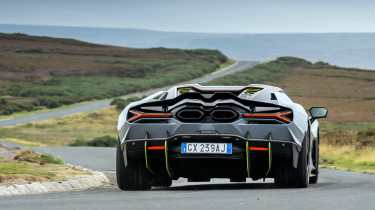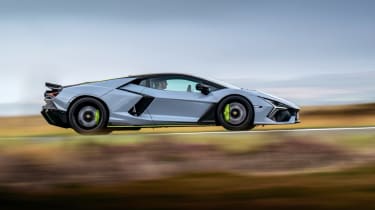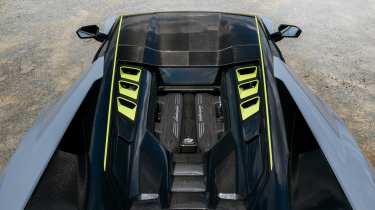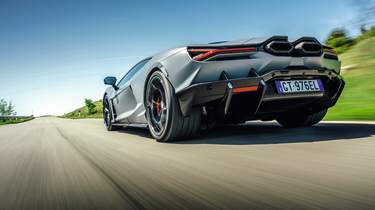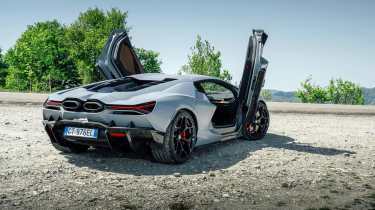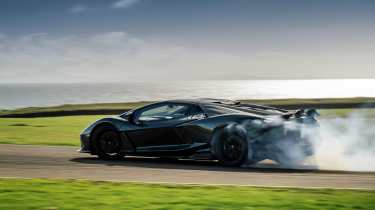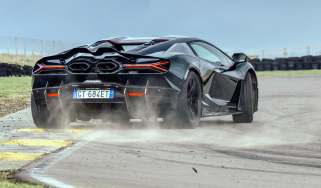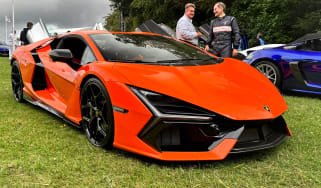Lamborghini Revuelto review – the ultimate modern supercar
Chock full of complex, cutting-edge tech, the Revuelto is more refined and capable than its predecessor, and it retains those all-important V12 Lamborghini thrills
Miura. Countach. Diablo. Murciélago. Aventador. When it comes to the Supercar Hall of Fame few can hold a candle to Lamborghini’s dynasty of top-tier, showstopping icons. As the latest in that long and iconic bloodline the new Revuelto carries a tremendous burden of expectation. One amplified by the emotive challenge of introducing electrification to Lamborghini’s showroom line-up. Bigger. Heavier. More complex. More expensive. The penalties for making the supercar sustainable present unpalatable reading, but Lamborghini has tried unusually hard to ensure the upside extends to more than pill-sweetening increases in power and performance.
The promise is a new take on Lambo’s time-honoured thrills. The fear is a compromised, tech-heavy car that’s somehow less than the sum of its parts. And the facts? Well, it is faster and more powerful. And yes, it is bigger – 1 inch higher and 6 inches longer – and it weighs 1772kg dry versus 1550kg for the Aventador Ultimae. At £450k before options it’s also significantly more expensive. And yet, the Revuelto’s nose-to-tail reinvention of Lambo’s familiar recipe is undeniably compelling.
> Aston Martin Vanquish 2025 review - Britain’s Ferrari 12 Cilindri rival
The powertrain comprises three electric motors plus the all-important (and completely redesigned) 6.5-litre V12, which has been rotated 180 degrees and mated to a new eight-speed DCT gearbox that now sits behind the engine. There’s all-wheel drive, but instead of a propshaft running to the front axle, the Revuelto has electric motors powering each front wheel, while the 814bhp V12 and the third electric motor send drive to the rear. Combined maximum power is 1001bhp, top speed over 217mph, and 0-62mph is in the mid‑2s. There’s no official quoted figure for combined torque, but the V12 alone develops 535lb ft, while each of the front motors is capable of 258lb ft, so let’s just say low-end grunt shouldn’t be lacking.
The whole shebang is connected via a super-smart network of stability controllers, which use the fine precision and instant response of the electric motors to manage the rate of rotation at each wheel, both under power and under braking. Four-wheel steering provides increased attack into corners and torque vectoring on the front axle keeps the front end nailed to your chosen line once you get on the power. That much propulsion in a chassis that can deploy it is a mouth‑watering prospect.
It’s 28 years since I first visited the Lamborghini factory. One vivid memory from that time in Sant’Agata is a conversation with fabled test driver Valentino Balboni, who kindly talked me around the Diablo Roadster VT I was there to drive before handing me the key. Proudly lifting the huge engine cover he gazed at the vast naturally aspirated V12 as though transfixed. ‘Lamborghini has never needed vee‑ag‑ra!’ he proclaimed in his distinctive Emilian drawl, chuckling as he cast aspersions on those supercar makers who employed forced induction to deliver the goods.
I wonder what he’d make of the Revuelto? He’d surely love its new naturally aspirated 6.5-litre V12 – all 125bhp-per-litre and 9500rpm of it – but I doubt he’d give a flying axial-flux for the trio of electric motors and bank of lithium-ion batteries, even if they do lift total power just into four figures. Then again, if the extra performance comes with greater exploitability and little or no reduction in drama then surely even Balboni would concede Lamborghini has preserved the things which matter most while expanding the overall experience.
We arrive at the gates of Sant’Agata for our audience with the Revuelto. The factory campus has expanded almost beyond recognition over the decades, the state-of-the-art facility now occupying a huge tranche of land. Carbon neutral since 2015, the Lamborghini plant has wholeheartedly embraced sustainability, using renewable natural gas and solar energy for power, planting 10,000 oak trees and creating hives housing upwards of 600,000 bees, amongst other green initiatives that benefit the region. This is much more than tokenism.
Some things don’t change. The scissor doors still swing upwards in time-honoured fashion and the Revuelto looks every inch the Lambo flagship. It’s the same story inside, at least so far as the basic architecture is concerned. There’s more headroom and legroom, but the windscreen is madly raked and as large as a department store window. Endless A-pillars start somewhere by your head and plunge out of sight, and the sense of sitting at the pointy end of an arrowhead is as strong as ever.
There’s a clear McLaren influence in the portrait orientation of the centre screen. Likewise the way you interact with the chassis, aero and powertrain modes. It’s not quite as intuitive as the Artura’s mix of rockers and buttons but operating the quartet of small rotary switches on the steering wheel soon becomes close to second nature. The passenger display gives off strong Ferrari vibes and, of course, there’s the Top Gun starter button with flip-up guard. I feel the need, etc. 'A bit like glancing into the cockpit of a 747, at first sight it’s a slightly bewildering array of buttons on the front and back of the steering wheel and you wonder how you’ll ever learn what they all do, but you soon realise that they’re actually quite intuitive.' – Henry Catchpole, evo issue 338
Polite isn’t a word you’d associate with the Revuelto’s predecessors, especially on start-up, but that’s exactly what this car is. In fact, you don’t so much start it up as switch it on, the V12 only bursting into life when you elect to switch out of EV or hybrid modes. There’s a certain novelty to the lack of fanfare, but such demure behaviour is wholly out of character for a V12 Lambo. It’s a sign of the times, but is it indicative of a somewhat neutered Lamborghini that has lost some of its extrovert streak?
We’ve got all day to find out. The roads in the immediate vicinity of Sant’Agata aren’t great for driving or photography, but the Raticosa Pass is within easy striking distance. Famed for being one of the more challenging sections of the legendary Mille Miglia route (and spitting distance from the equally famous Futa Pass), it winds its way through the sun-dappled slopes of the Apennine mountains, from Tuscany in the south to Emilia-Romagna – the heart of supercar country – further north.
Though they lack the scale and spectacle of the Alps or Dolomites there’s something special about this modestly magnificent route, with miles of fast, flowing driving and fabulous views across the wooded valleys punctuated by sleepy villages and snaking sequences of corners. The famous Mugello circuit is nearby, which accounts for why it’s a mecca for bikers of the leather-clad, not Lycra-wearing kind, and there’s even a great place to grab a 105-octane espresso or delicious lunch in the shape of the Chalet Raticosa. If Carlsberg did driving roads…
Heading away from the factory is a chance to get comfortable with the Revuelto. First impressions suggest this is the most Audi-fied Lambo yet, thanks to that politeness on start-up and the impressive integration of ICE and hybrid systems. If you come to the Revuelto with the muscle memory of intimidating drives in the Aventador, Murciélago or Diablo, the ease of use and lightness of touch is welcome, if unexpected. Big V12 Lambos have never been this easy to drive.
Machismo has been integral to Ferruccio’s fiercest creatures since the Countach. When your emblem is a fighting bull, that goes with the territory, but the way in which the Huracán was honed in the last few years of its life points to an engineering culture that wishes to create cars with nuanced, exploitable, pinpoint dynamics. The Revuelto certainly feels different from its predecessors in this respect, its approachability and wieldiness apparent from the start.
It’s a feeling that grows with miles and familiarity. There’s a measured consistency to the major controls that not only puts you at ease but points to an extraordinary effort to finesse all your sources of control and feedback. The steering is now fixed-ratio, replacing the dynamic ‘active-ratio’ rack as found on the Aventador. It is a welcome change, bringing connection and consistency that makes the Revuelto easier to place with instinctive accuracy.
The brakes are equally impressive, not least because they blend the effects of regenerative and friction retardation. Brake feel is one of the areas that let the Huracán down, with overly sharp initial response that’s hard to drive around, while the Aventador Ultimae suffered from too much initial travel. The Revuelto rights those wrongs with a firm pedal that’s so progressive it’s hard to believe the system is juggling the drag of those electric motors as well as the bite of pads on carbon discs.
The various dynamic modes make meaningful differences, turning up the dynamic brightness, volume and intensity like a rheostat. Città (City) is EV-only and gives you 178bhp to play with (if only for 6 miles), Strada jumps to 874bhp, Sport to 894bhp, and Corsa and Corsa ESC-off give you the full nine yards. Each comes with its own blend of strategies for damping, gearbox, torque vectoring, throttle response, active aero, and traction and stability control, so you can dial the car in nicely. Without really thinking about it I find myself driving most of the time in Sport. Just under 900bhp is plenty, and the torque vectoring’s level of response and agility has the uncanny effect of truly shrinking the Revuelto around you. It really is a revelation, slicing through the Raticosa’s twists and turns in a manner that would simply not be possible in the Aventador. As for Corsa? It’s nuts.
Whether you’re in Sport or Corsa, a fully-lit Revuelto goes in a manner quite unlike any Lambo before it. Yes, there’s the drama of a big, high-revving V12, but the way in which the battery power augments and intensifies the sensations of endless acceleration elevates it to a whole new level. In-gear reach has always been a hallmark of these cars, but in earlier models it was the sense of a huge engine getting on top of a loping ratio that defined the experience. It was an epic sensation unique to Lambos (and maybe Paganis), but combined with their unwieldy dimensions, such long-legged performance exacerbated the feeling that a Diablo, Murciélago or Aventador was not a car you could readily hustle.
In evo issue 338's V12s triple test, Henry Catchpole said: 'In a straight line the performance is prodigious, with the hybrid powertrain producing instant acceleration that is then sustained in an incredibly linear fashion. The Revuelto has Veyron numbers but delivers them in a way that is not only more evocative in terms of the soundtrack, but also more engaging and encouraging in terms of how it lets you deploy the power through the wheels.
The Revuelto turns that theory on its head. Largely thanks to the early swell of torque from the electric motors. It seems ridiculous to suggest a 6.5-litre V12 lacks torque, but having that early helping hand from the hybrid system makes a huge difference. As does the new eight-speed double-clutch transmission, which packs an extra ratio versus the Aventador’s old single-clutch ISR ’box, and shifts more decisively and consistently.
There’s also that torque-vectoring effect, which helps the Revuelto rotate into corners more keenly. Much muttering has been made about the additional weight of the hybrid powertrain, but the added grunt more than masks the gain in mass. Better, the way the torque is managed shrinks the Revuelto to the point where you soon hustle it like a Huracán. The mass also feels better contained, especially during successive rapid direction changes, when the pendulous weight and height of the V12 always made its presence felt.
'Its dampers may be working overtime in the arches like the proverbial swan’s feet below the water, but the sensation behind the wheel is one of utter mastery of the road. It’s not that it leaves you feeling detached from the ground beneath the tyres, just that the car isn’t ruffled or disturbed. You can pick lines and deploy power with confidence, aware of but undistracted by the tortuousness of the tarmac.' – Henry Catchpole, evo issue 338
For some the loss of that intimidation factor might diminish the occasion and drama of owning and driving an ultimate Lamborghini. I’d be lying if I said the sweaty-palmed fear of manhandling those unwieldy machines didn’t come with its own masochistic pleasure, but the more you drive the Revuelto, the more you appreciate its increased capability and fall for the dizzying rush of battery and V12 propulsion.
Simply put, a Revuelto would leave its predecessors for dead – Aventador SVJ included – thanks to incendiary acceleration and elevated, clearly defined and readily explored dynamics. That said, supercars of this calibre have never been solely about speed. Above a certain level it’s feeling and emotion that count for more – something Lamborghinis have always had in spades. That Lamborghini has remained committed to the full-fat V12 is the key to the Revuelto’s might and majesty. Such defiance in the face of widespread downsizing confers the Revuelto with a massive advantage over cars like the Ferrari SF90, because it stays true to the notion that supercars are in the business of shock and awe. The great irony in all this is it’s the hybrid elements of the powertrain that allow you to enjoy and explore the V12 as never before.
Unsurprisingly, when judged objectively the Revuelto is a far better car than its predecessors. Faster yes, but also blessed with far greater bandwidth, more deployable performance and a chassis that is no longer overshadowed by its powertrain. That it also shoulders its social and environmental responsibilities is no less commendable, especially as the new V12 means there’s minimal dilution of the time-honoured drama we expect from Lamborghini.
Downsides? Well, mighty though the V12 is, the soundtrack is a little less organic. Or at least less gritty, the raw, guttural voice of the Aventador exchanged for something smoother and less animalistic. It doesn’t diminish its authenticity, but diehards will say it reduces the sense of mechanical drama. The upside of this less dominant, more nuanced powertrain is a car that’s not such a relentless sensory assault. You could drive it on long journeys and not be fatigued. And there’s certainly headroom for a more raucous S, SV or Jota.
Crucially it’s a more emotional and readily likeable car than the regular Ferrari SF90, which has struggled to assert itself as a compelling series-production Ferrari flagship. Try and tease a bullish comment (no pun intended) from Lambo spokespeople and they remain respectful, indeed almost reverential, about their neighbours in nearby Maranello. Yet there’s no doubt the Revuelto ruthlessly exposes why Ferrari’s V8 hybrid is strangely hard to love.
Track test
Jump into the Revuelto, notice how much more room there is and yet how the driving position still has remnants of Aventador about it (oddly upright and not fully immersed in that carbon structure in the way of, say, a McLaren or even a Maserati MC20), and then scan the steering wheel for clues about how to operate this monster. On the left side of the wheel is a rotary switch that allows you to select Città, Strada, Sport, Corsa and Corsa ESC Off modes. It affects magnetic dampers, four-wheel drive and torque-vectoring strategy, traction and stability control, gearbox programming, throttle response, powertrain settings and the active aerodynamics. Refreshingly, whatever the mode chosen, the steering speed and assistance remain consistent. Hallelujah.
Its counterpart dial on the right of the wheel selects Recharge, Hybrid or Performance mode, which mostly do what they say on the tin. City mode is EV only and limited to 178bhp; Strada provides access to 874bhp, aero set to maximum stability and relatively comfortable dampers; Sport bumps the power to 895bhp and is about agility and is said to be the most ‘drifty’ of the modes, and Corsa turns everything up to maximum and is designed for lap time and all-out performance.
Sensations come thick and fast. The steering is very light and has that clean, smooth feel that’s typical of ePAS and the complete opposite of the Aventador’s heavy, sticky-feeling rack. In combination with the rear steering – which can turn between +3 and -3 degrees for low-speed manoeuvres but in dynamic situations is inputting just 0.5 degrees – the Revuelto feels instantly more agile than any Aventador I’ve driven and gives an impression of lightness that’s welcome and unexpected. The gearbox is transformed, too. Here it fosters ‘emotion’ simply by giving almost uninterrupted access to 1001bhp. It’s fast, hits with just a little jolt for dramatic effect and feels right up there with the best from the likes of Porsche and Ferrari. Maybe it’s not quite as manic and mechanical feeling as a 296 GTB’s, but then the Revuelto does have a 6.5-litre V12 to fall back on…
The powertrain is simply fantastic. There isn’t the pure, singular howl of an Aventador SVJ at high revs, but for response, reach and blood-draining acceleration the combination of the new V12 and the electrical boost is beyond reproach. Even on the wide expanses of a track, the Revuelto is the sort of fast that makes you feel super-powered and very puny all at the same time. A Ferrari SF90 feels just as absurd and smaller too, but the amazingly precise response of a big V12 with the added hit of electrical assist is so much more special in operation.
The comparison with the SF90 is instructive because the two cars’ differing approaches are so obvious and tangible. Despite both relying heavily on the technological tools at their disposal, the Lamborghini has deliberately tried to hide the various levers it’s pulling and create a very natural, almost classical dynamic feel and balance. The torque vectoring may be over-speeding the outside wheel in low-speed turns and doing the opposite to aid stability in the really fast turns, but you don’t feel that.
Nor is there the sense that the four-wheel drive is constantly massaging and managing the balance. In an SF90 there’s a lot of manipulating going on and you know when the front axle is fully engaged and trying to drag the car straight. It’s fascinating but often counter-intuitive, and the lack of consistency can make the car a bit of an enigma to untangle. The Lambo is a breeze to read and exploit by comparison. Mostly this is a very neutral car – much more so than early Aventadors – but it also reacts with real energy as you attempt to balance it under power. There’s a delicate sense of poise and adjustability that’s at odds with the sheer forces at work.
However, the Revuelto is still a big car with a very big engine and heavy gearbox swinging around behind you and, at times, there’s no disguising it. It jinks and sways under heavy braking, and as well as the predictable power oversteer that’s very easy to work with and finessed really well by the ESC (which can use the rear electric motor to create drag on the engine rather than cutting sparks), the car will also swing into oversteer pretty quickly if you turn in on the brakes. Following the wrung-out instructors is fantastic, but further highlights the fight going on to keep such power and weight tied down, the Revuelto bucking and hopping over lateral bumps and looking a right old handful even though from the inside it is mostly very calm.
Overall, though, the car is a massive leap on and copes really well with the challenge of a racetrack. New ten-piston carbon-ceramics have radically better feel than the brakes of the Aventador or even a Huracán, which still suffer from dead travel and then very grabby bite. The engine truly is outrageous, and the crazy thing is that even with 9500rpm to play with it’s still very easy to hit the limiter, such is the rate of acceleration and the effortless way the V12 revs out. It feels like it would run another 1000rpm without strain. Even on standard Bridgestone Potenza Sport tyres (the Race variant seen on the Huracán STO is not available for this car) it’s fast, too, matching an STO for lap time and probably for less effort.
Lamborghini Revuelto specs
| Engine | 6.5-litre V12 & three electric motors |
| Power | 1001bhp |
| Torque | 595lb ft |
| Weight | 1772kg (dry) |
| Power-to-weight | 565bhp/ton (dry) |
| 0-62mph | 2.5sec |
| Top speed | 217mph |
| Price | £454,830 |

